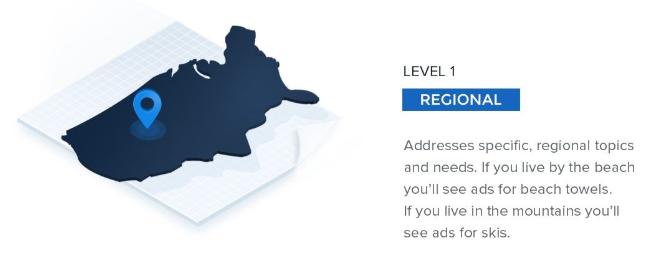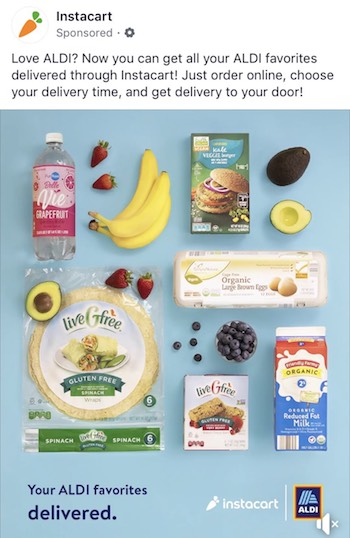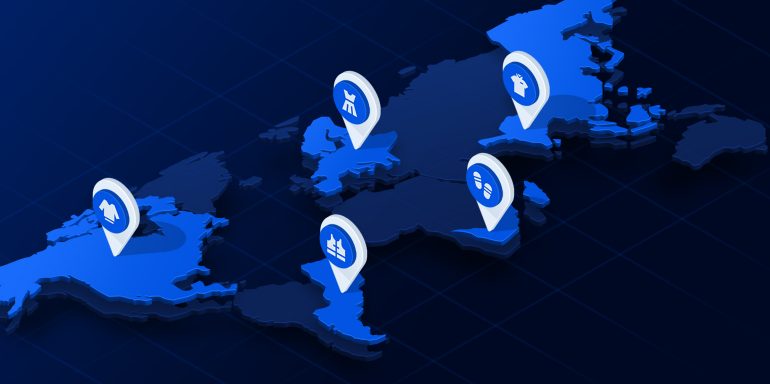Since people in different locations are bound to display different characteristics and have various wants and needs, geographic location is an integral factor in determining market positioning and product sales.
This is something you should take into consideration when creating your marketing strategy. More specifically, it’s why you should have geographic segmentation in your marketing and advertising campaigns.
What is geographic segmentation and why is it important?
Geographic segmentation divides a target market by location so marketers can better serve customers in a particular area. This type of market segmentation is based on the geographic units themselves (countries, states, cities, etc.), but also on various geographic factors, such as climate, cultural preferences, populations, and more.
The following ads target by geographic unit. Searching for “lawn care,” Google displayed two options for lawn care in my immediate area:

In my Facebook feed, this ad showed, also based on where I live:

In addition to knowing the geographic segmentation definition, it’s even more important to know why it’s necessary for marketing.
Knowing your customers well allows you to offer a more personal value proposition that addresses specific topics and needs. This all begins with where they’re located:

Product relevance and advertising effectiveness often depend on different geographic variables. Matching those products and advertising techniques to specific geographic locations means you’re reaching more relevant audiences and not wasting your time or budget.
This is especially true for large, multinational businesses because it helps them understand location-based attributes of a specific target market, which enables them to better address the varying wants and needs of customers in these different regions.
Geographic segmentation is also ideal for small businesses with limited budgets that serve a wide customer base in a local or regional territory. It allows them to focus their marketing efforts on a defined area of interest, effectively avoiding inefficient spending.
Compared to other segmentation types -- demographic, psychographic, or behavioral -- geographic segmentation is relatively easy to perform. It’s much easier to identify someone’s location than it is to determine the different elements of their psyche or their behavioral tendencies. While geography is objective, personality traits, interests, and behaviors are all much more subjective.
Remember, geographic segmentation is not based solely on units of geography. You also need to consider other variables. Let’s take a look at those now.
Geographic segmentation variables
Climate
As its name suggests, climate-based segmentation involves marketing products based on a particular region’s climate.
For example, brands that typically sell winter apparel (such as Burton or North Face) should market their products in areas that are cold all year-round, because they’d probably fail to profit by marketing to warmer climates. Swimwear brands, on the other hand, should target warmer climates -- areas with beaches, resorts, etc. -- because that’s where they’ll generate the most business:

Products can also be considered more seasonal, instead of regional.
For instance, a retailer in the northern United States that sells products for multiple climates and conditions (e.g., Target or Walmart) should advertise their winter gear in the fall and winter months, and their summer gear in the spring and summer months.
Cultural preferences
Many companies practice cultural-based geographic marketing. Fast food and restaurant businesses are a prime example.
-
- McDonald's serves beer in their German restaurants, but not in the US. It reflects the difference in drinking preferences between the two cultures. They’ve also incorporated local foods on their menu in some locations -- the McArabia in the Middle East, banana pie in Brazil, and the McVeggie, salsa bean burger, and other unique items in India:

- Seafood is heavily marketed along the east and west coast in the US. since there is a constant supply of fresh seafood throughout the year.
- In Asian countries, eating habits are highly dependent on religious ceremonies. The Chinese eat dumplings during the Spring festival in honor of their relationship with God. So marketing strategies would correlate to that.
Population type and density
People living in urban, suburban, and rural areas often have contrasting wants and needs, so to make advertising more personalized, geographic segmentation makes sense.
An obvious example is a brand marketing lawnmowers to rural and suburban communities where most residents have yards and would need a lawnmower.
Consider a bicycle company as another example. Ideally, here’s how they would market their varying product line:
- Urban areas: Lightweight bikes with skinny tires, for riding among traffic
- Suburban areas: Comfortable, long-range, race bikes
- Rural areas: Durable mountain bikes with thick tires for uneven terrains
Each area has a population with varying biking needs and should be addressed in such a way.
New territory
Geographic segmentation is commonly used when an organization launches a product or service in a new geographic location.
Instacart delivered the following Facebook ads knowing that these grocery stores are in my residential area:


Since grocery delivery services are still a new market, the company is likely looking for customer growth in many different areas.
Up close and personal with geographic segmentation
Geographic segmentation perfectly complements a marketing strategy. Whether you’re using it in coordination with the other types of segmentation or on its own. It is imperative to target products or services based on where your consumers reside. Since the better you know a customer, the more personalized offer you can provide, and the higher the chance your campaign will result in the desired outcome.
Geographic segmentation and personalization don’t stop with an ad click. Get an Instapage Enterprise demo and see how our platform allows you access to a suite of tools to significantly improve your advertising ROI and streamline your post-click process.

Get a Personalization Demo
See how easy it is to create unique experiences for any audience you target.
